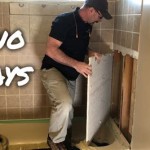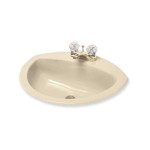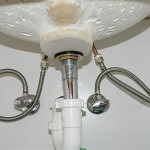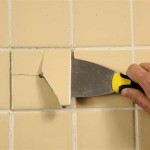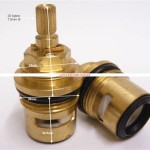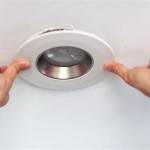How To Remove an Old Bathroom Mirror
Removing an old bathroom mirror can seem daunting, but with the right tools and precautions, it can be a manageable DIY project. This article provides a step-by-step guide to safely and effectively remove a bathroom mirror, whether it's glued to the wall or mounted with clips.
Preparing for Mirror Removal
Proper preparation is crucial for a smooth and safe mirror removal process. Gathering necessary supplies and taking protective measures will minimize the risk of injury and damage.
- Cover the floor and countertop: Protect these surfaces from falling glass shards by covering them with drop cloths or old blankets.
- Wear safety gear: Eye protection, work gloves, and long sleeves are essential to prevent injuries from broken glass and sharp tools.
- Gather tools and materials: Assemble the necessary tools, including a putty knife, duct tape, pry bar, hammer, razor blade scraper or utility knife, heat gun or hairdryer (optional), and mirror adhesive remover (if applicable).
Removing a Glued Mirror
Mirrors adhered directly to the wall require careful handling to prevent shattering during removal. Several techniques can be employed to loosen the adhesive and safely detach the mirror.
- Apply heat: A heat gun or hairdryer can soften the adhesive, making it easier to separate the mirror from the wall. Use caution to avoid overheating the mirror, which could cause it to crack.
- Use a putty knife or pry bar: Carefully insert a putty knife or pry bar behind the mirror, working slowly and gently to pry it away from the wall. Use multiple pry points to distribute pressure evenly.
- Employ a wire saw (for larger mirrors): For larger, heavier mirrors, a wire saw can be used to cut through the adhesive. This involves feeding a thin wire behind the mirror and sawing through the adhesive with a back-and-forth motion.
- Work in sections: Break down the removal process into smaller, manageable sections, especially for large mirrors. This reduces the risk of the entire mirror shattering.
Removing a Mirror Mounted with Clips
Mirrors secured with clips are generally easier to remove than glued mirrors. Identifying the clip type and using appropriate tools simplifies the process.
- Locate the clips: Identify the location and type of clips holding the mirror in place. Common types include J-clips, L-clips, and spring clips.
- Loosen or remove the clips: Depending on the clip type, you may need to loosen screws, pry open clips, or slide them off. Refer to the manufacturer's instructions if available.
- Carefully lift the mirror: Once the clips are detached, gently lift the mirror away from the wall. Have a helper assist with larger mirrors to prevent dropping.
Cleaning the Wall After Mirror Removal
After the mirror is removed, the wall will likely require cleaning to remove residual adhesive or mounting hardware. Proper cleaning prepares the surface for future installations.
- Remove adhesive residue: Use a razor blade scraper or adhesive remover to carefully scrape off any remaining adhesive. Follow the manufacturer's instructions for the adhesive remover.
- Patch holes and imperfections: Fill any holes left by screws or clips with spackle. Sand smooth once dry.
- Clean the wall surface: Wash the wall with a suitable cleaning solution to remove dust, debris, and any remaining adhesive residue. Allow the wall to dry completely before installing a new mirror or other wall covering.
Disposing of the Old Mirror
Proper disposal of the old mirror is important for safety and environmental considerations. Taking appropriate precautions prevents injuries and ensures responsible waste management.
- Wrap broken mirror pieces: Carefully wrap any broken pieces of mirror in thick cardboard or several layers of newspaper. Secure the wrapping with tape.
- Label the package: Clearly label the package as "broken glass" to alert waste handlers.
- Check local regulations: Contact your local waste management authority for specific guidelines on disposing of broken mirrors and large glass items. Some areas require special handling or drop-off locations.
- Consider donating intact mirrors: If the mirror is intact and in good condition, consider donating it to a local charity or reuse center.
Important Safety Reminders
Throughout the mirror removal process, prioritize safety to minimize the risk of accidents. Adhering to safety guidelines protects both individuals and the surrounding environment.
- Work slowly and carefully: Avoid rushing the removal process. Take your time and be mindful of your movements.
- Keep the area clear: Ensure the work area is free of obstructions and distractions to prevent accidents.
- Have a helper: Enlist the help of another person, especially when handling large or heavy mirrors.

How To Remove A Bathroom Mirror Lowe S

How To Safely And Easily Remove A Large Bathroom Builder Mirror From The Wall Site Title

How To Remove Mirror Off Wallsafely

How To Safely And Easily Remove A Large Bathroom Builder Mirror From The Wall Site Title

How To Remove A Mirror Glued The Wall Forbes Home

How To Safely And Easily Remove A Large Bathroom Builder Mirror From The Wall Site Title

Easily And Safely Remove A Bathroom Wall Mirror That Is Glued On
:strip_icc()/Design_CathieHongInteriorsPhoto_ChristyQPhotography-b2290decbe0e4d0b952f280fb7bdc896.jpg?strip=all)
How To Remove A Bathroom Mirror From The Wall

How To Remove A Bathroom Mirror Lowe S

How To Safely And Easily Remove A Large Bathroom Builder Mirror From The Wall Site Title
Related Posts

